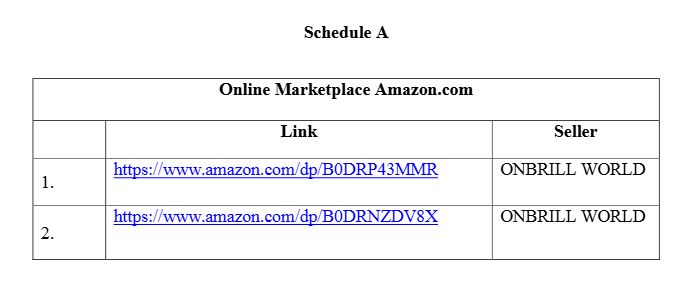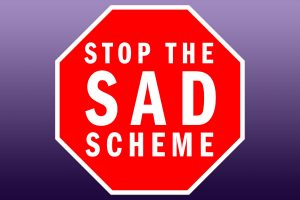Court Sanctions Plaintiff’s Lawyer for Unverified Claims That the Defendant Was Hiding–Guangzhou Youlan Technology Co. Ltd. v. Onbrill World
This is a SAD Scheme-adjacent design patent case against an Amazon merchant. I say “adjacent” because the plaintiff’s lawyer apparently cloned-and-revised SAD Scheme templates but made two major variations: (1) the complaint only names one defendant, not hundreds, and (2) the defendant’s identity wasn’t sealed. I’m not sure why the lawyer chose to start with SAD Scheme templates in this circumstance.
Unsurprisingly, the clone-and-revise was done poorly. For example, the complaint cross-references a sealed Schedule A, but Schedule A was never sealed and the defendant’s name is right there on the caption.
Schedule A typically enumerates a long list of e-commerce merchants and URLs. In a single-defendant case, it becomes gratitutious. Here are the total contents of the never-sealed Schedule A, nevertheless filed as a separate docket entry:
The plaintiff easily could have incorporated these two URLs into the complaint and skipped the references to Schedule A entirely.
As usual with SAD Scheme cases, the plaintiff claims that the defendant is hiding its true name and location. It’s unclear if this is part of the bad clone-and-revise, or if the lawyer relied solely on the plaintiff’s fact representations to its lawyer. Either way, these allegations are unverified.
Judge Daniel started asking the plaintiff’s lawyer some tough questions about the defendant’s location. That didn’t go well in the initial hearing:
The Court cautioned plaintiff’s counsel that it would start asking about any investigation plaintiff’s counsel conducted with respect to his justifications for alternative service if plaintiff’s counsel continued.
Plaintiff’s counsel continued…
🤣 I mean, if a judge warns counsel to stop talking and counsel keeps talking despite the warning, they get what they get…
The question is how the plaintiff’s lawyer knew that the defendant provided a fake name and address. The short answer is that the client said that to the lawyer, and the lawyer did not independently confirm the facts. Judge Daniel is not pleased:
The Court finds that plaintiff’s counsel failed to conduct a reasonable inquiry under the circumstances prior to claiming that the defendant, “on information and belief . . . has provided false name and physical address information in its registration for the Defendant Online Marketplace Accounts in order to conceal their locations and avoid liability for its unlawful conduct.” The record shows that neither the plaintiff nor plaintiff’s counsel knew that to be the case. The record further shows that neither the plaintiff nor plaintiff’s counsel had any prior experience with the defendant, which means that neither had a basis to form any beliefs as to the defendant’s identity or location. Further, the record shows that plaintiff’s counsel did nothing to investigate the defendant’s identity or location….
plaintiff’s counsel simply took the information provided by his client and filed suit…
Rather than ask Amazon to identify who the defendant was, hire an investigator to look into the limited information provided by the plaintiff, or otherwise check to see whether the defendant provided accurate information, plaintiff’s counsel claimed—without any evidentiary foundation—that the defendant provided a false name and operated under multiple fictitious names.
Judge Daniel is further irritated by what looks like legacy verbiage from the bad clone-and-revise job:
More troubling is the picture plaintiff’s counsel painted of the defendant without knowing anything about the defendant. According to plaintiff’s counsel: “[d]efendant has attempted to avoid liability by both concealing both their identities”; “an order authorizing service of process by email and/or electronic publication is proper as a result of the Defendant’s intentional efforts to conceal their identifies and operate their business online”; “Defendant has engaged in many deceptive practices in hiding their identities and accounts”; “[p]ast investigation and discovery of Online Marketplace Accounts in similar cases reveal that the Defendant appears to have provided false physical address information to the online marketplaces in order to avoid full liability.” Plaintiff’s counsel has not come forward with any credible evidence that supports any of those claims. And nowhere did plaintiff’s counsel tell the Court what he actually knew—that neither his client, Mr. Shen, nor plaintiff’s counsel had any prior knowledge or experience with the defendant and that no one had verified or attempted to verify who the defendant was or where the defendant was located.
All of this culminates in a rare Rule 11 sanction. The sactions are modest–$500 and 2 hours of CLE. Still, Rule 11 is so lightly enforced that any Rule 11 sanction is a stinging rebuke. The court doesn’t mince words: “The CLE is necessary because the Court finds that plaintiff’s counsel does not comprehend what Rule 11 requires.” 🔥
 Judge Daniel concludes with a reference to the Seventh Circuit’s language in the Dolls Kill case:
Judge Daniel concludes with a reference to the Seventh Circuit’s language in the Dolls Kill case:
this Court has cautioned and, at times, sanctioned other plaintiff’s counsel who made unfounded allegations or claims in similar cases involving alleged infringement by overseas defendants. And other courts in this district have been troubled by the allegations and claims raised by plaintiff’s counsel in similar cases. See, e.g., Dolls Kill, Inc. v. Mengeryt, No. 24-2841, slip op. at 3 (7th Cir. Oct. 30, 2025) (“[W]e acknowledge that a flood of similar claims of intellectual property infringement with no particular ties to the Northern District of Illinois have swamped and, understandably, troubled the district courts . . . .”).
Is the SAD Scheme abusive or beset by bad lawyering? ¿Por qué no ambos?
Case Citation: Guangzhou Youlan Technology Co. Ltd. v. Onbrill World, Docket No. 1:25-cv-11051 (N.D. Ill. complaint filed Sep 12, 2025). CourtListener page. This order is dated November 12, 2025. The plaintiff’s attorney is Robert Michael DeWitty.
Prior Blog Posts on the SAD Scheme
- SAD Scheme Cases Are a Cesspool of IP Owner Overreaches–Nike v. Quanzhou Yiyi Shoe Industry
- District of New Jersey Adopts SAD Scheme Standing Order
- Court “Sanctions” SAD Scheme Judge Shopping—Crimpit v. Schedule A Defendants
- Chicago-Kent SAD Scheme Symposium TOMORROW
- Amicus Brief Urges Seventh Circuit to Award Attorneys’ Fees in SAD Scheme Case–Louis Poulsen v. Lightzey
- Court Rejects Schedule A Claims Against Sellers of Compatible Parts/Accessories (Cross-Post)
- Judge Kness: the SAD Scheme “Should No Longer Be Perpetuated in Its Present Form”–Eicher Motors v. Schedule A Defendants
- SAD Scheme Lawyers Sanctioned for Judge-Shopping–Dongguan Deego v. Schedule A
- Judge Ranjan Cracks Down on SAD Scheme Cases
- Because the SAD Scheme Disregards Due Process, Errors Inevitably Ensue–Modlily v. Funlingo
- SAD Scheme-Style Case Falls Apart When the Defendant Appears in Court—King Spider v. Pandabuy
- Serial Copyright Plaintiff Lacks Standing to Enforce Third-Party Copyrights–Viral DRM v 7News
- Another N.D. Ill. Judge Balks at SAD Scheme Joinder–Zaful v. Schedule A Defendants
- Judge Rejects SAD Scheme Joinder–Toyota v. Schedule A Defendants
- Another Judge Balks at SAD Scheme Joinder–Xie v. Annex A
- Will Judges Become More Skeptical of Joinder in SAD Scheme Cases?–Dongguan Juyuan v. Schedule A
- SAD Scheme Leads to Another Massively Disproportionate Asset Freeze–Powell v. Schedule A
- Misjoinder Dooms SAD Scheme Patent Case–Wang v. Schedule A Defendants
- Judge Hammers SEC for Lying to Get an Ex Parte TRO–SEC v. Digital Licensing
- Judge Reconsiders SAD Scheme Ruling Against Online Marketplaces–Squishmallows v. Alibaba
- N.D. Cal. Judge Pushes Back on Copyright SAD Scheme Cases–Viral DRM v. YouTube Schedule A Defendants
- A Judge Enumerates a SAD Scheme Plaintiff’s Multiple Abuses, But Still Won’t Award Sanctions–Jiangsu Huari Webbing Leather v. Schedule A Defendants
- Why Online Marketplaces Don’t Do More to Combat the SAD Scheme–Squishmallows v. Alibaba
- SAD Scheme Cases Are Always Troubling–Betty’s Best v. Schedule A Defendants
- Judge Pushes Back on SAD Scheme Sealing Requests
- Roblox Sanctioned for SAD Scheme Abuse–Roblox v. Schedule A Defendants
- Now Available: the Published Version of My SAD Scheme Article
- In a SAD Scheme Case, Court Rejects Injunction Over “Emoji” Trademark
- Schedule A (SAD Scheme) Plaintiff Sanctioned for “Fraud on the Court”–Xped v. Respect the Look
- My Comments to the USPTO About the SAD Scheme and Anticounterfeiting/Antipiracy Efforts
- My New Article on Abusive “Schedule A” IP Lawsuits Will Likely Leave You Angry
- If the Word “Emoji” is a Protectable Trademark, What Happens Next?–Emoji GmbH v. Schedule A Defendants
- My Declaration Identifying Emoji Co. GmbH as a Possible Trademark Troll


Pingback: Another Shill Article Tries to Normalize the SAD Scheme - Technology & Marketing Law Blog()